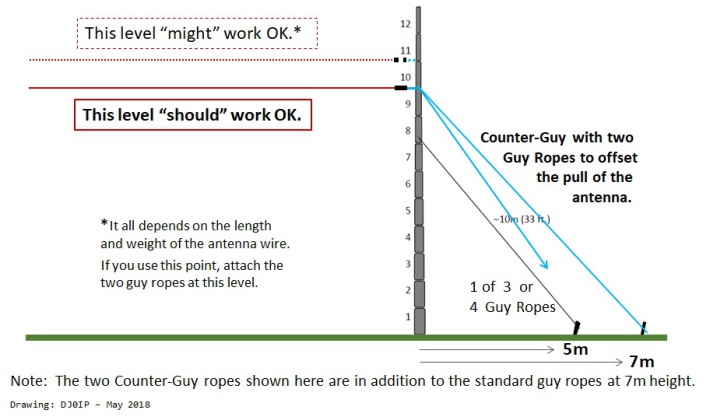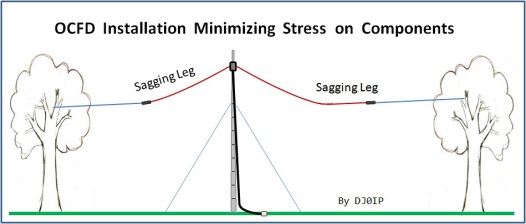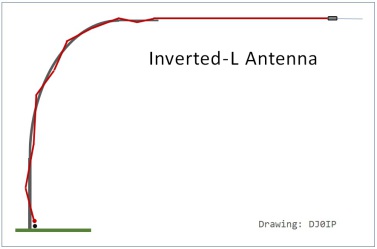1-Sided Loads
CONNECTING 1-SIDED LOADS TO FIBERGLASS SPIDERPOLES
Spiderbeam's lightweight telescoping fiberglass poles were designed for traveling hams, to be used for supporting wire verticals and lightweight dipole antennas. They are very wide at the bottom but quite thin near the top. This is the best compromise for obtaining height while maintaining low weight.
“Strength” vs. “Tube Diameter”
The strength of any tube varies significantly with the diameter of the tube.
- When we double the diameter of the tube, it is nearly 7x stronger.
- Double the diameter again and it is 46x as strong as the original tube.
When the wire of the vertical or the coax of the lightweight dipole is gently spiraled around the pole as it runs down the pole, the force applied to the pole is faily balanced, and the pole remains fairly straight.
These poles were not designed to be used as end-supports for dipole antennas, nor for supporting one-sided loads (i.e., Inv.-L antennas).
HOWEVER, they can be used for that, if you take special precautions:
- Lower the connection point to a safe level
- In many cases, you must connect the load quite a bit down from the top of the pole.
- Guy the pole at (or near) the point where the load connects, to counter the force of the one-sided load.
Spiderpoles are "thin wall", telescoping fiberglass poles. their wall thickness varies from 1mm to 2.5mm, depending on pole model and which segment. Thinner segments have thinner walls, and vice versa.
There are also "thick-wall" fiberglass poles with wall thicknesses of 4mm/5mm/6mm, but these are not in the Spiderbeam product portfilio. These poles are VERY HEAVY.
Thick-wall fiberglass poles are better suited for use as end-supports for dipoles, Inv.-V, or Inv.-L antennas, especially because they may be used without guying if the feedpoint of the antenna is also supported by a pole.
CONSTRUCTION CONSIDERATIONS:
It seems most antenna books tend to show dipole antennas as being strung between two end-supports. Antenna books in USA typically show dipoles being built with 12-AWG or 14-AWG wire. Both of these points are counter-productive to erecting a wire antenna high into the air when using fiberglass support poles.
In the interest of keeping weight low, 18-AWG wire is perfectly adequate for our antennas. Indeed, even 26-AWG is good enough, as long as you are not running 1500 Watts on 160m.
A dipole strung between two poles (or trees) tends to droop considerably at its feedpoint, especially when using thicker coax (i.e., RG-213). The center of a dipole is its point of maximum current; thus maximum radiation. In the interest of performance, we must strive to place the feedpoint as high in the air as possible.
In most cases, it is much better to use a tall thin-wall fiberglass pole as the center-support, let the ends droop, and connect to . . . whatever.
Example: Dipole / OCFD
Pictured here is an Off-Center-Fed Dipole, but a standard Dipole may be erected in the same way.
Often we have no trees available and wish to use a fiberglass pole as end support. In this case, the end-support poles have a 1-sided load.
- If we choose to use a thin-wall pole (i.e., Spiderpole), it MUST be guyed.
- If we use a thick-wall pole and erect it "stressless" as shown above, there is usually no need to guy the pole.
EXAMPLE: Inverted-L:
C A U T I O N / W A R N I N G
Although a Spiderpole may be safely used like this for a short period of time (i.e., a few days), if you leave it like this for a longer period of time, the Spiderpole may be permanently (slightly) bent and will not return to its original "straight-as-an-arrow" form.
Once it is slightly bent, it is more difficult to telescope in and out.
How long is "a longer period of time" ?
We don't know; it depends on the weather.




























